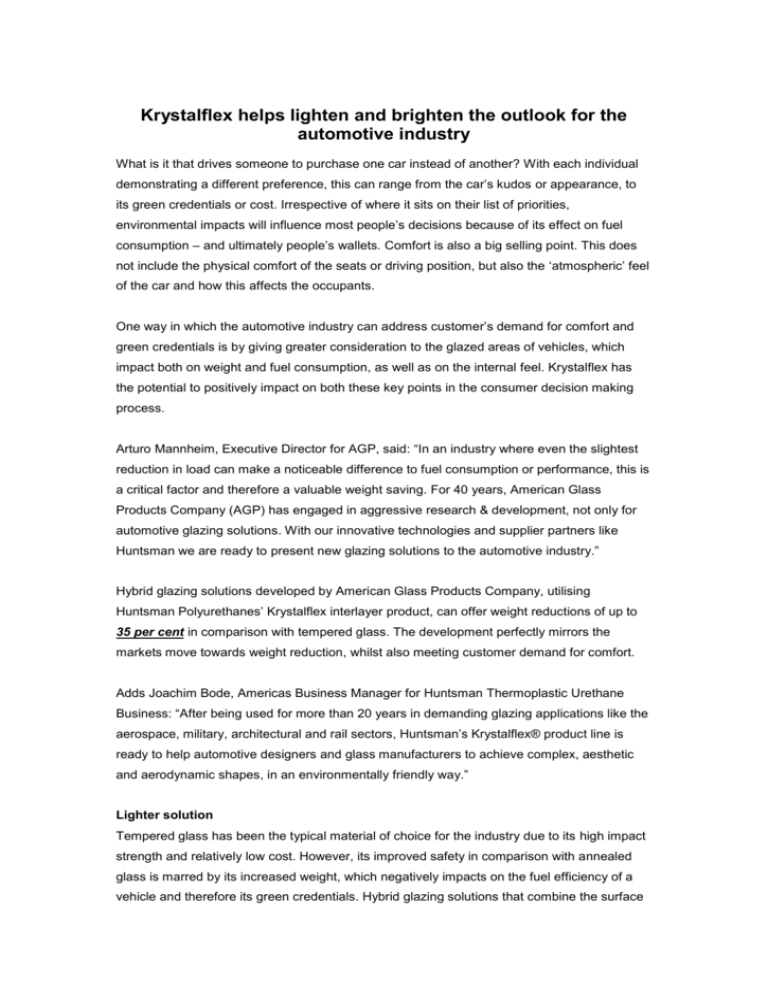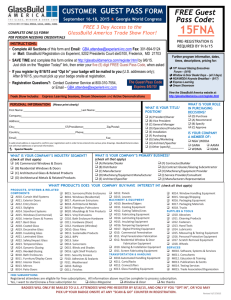It is widely accepted that there is a growing trend within
advertisement

Krystalflex helps lighten and brighten the outlook for the automotive industry What is it that drives someone to purchase one car instead of another? With each individual demonstrating a different preference, this can range from the car’s kudos or appearance, to its green credentials or cost. Irrespective of where it sits on their list of priorities, environmental impacts will influence most people’s decisions because of its effect on fuel consumption – and ultimately people’s wallets. Comfort is also a big selling point. This does not include the physical comfort of the seats or driving position, but also the ‘atmospheric’ feel of the car and how this affects the occupants. One way in which the automotive industry can address customer’s demand for comfort and green credentials is by giving greater consideration to the glazed areas of vehicles, which impact both on weight and fuel consumption, as well as on the internal feel. Krystalflex has the potential to positively impact on both these key points in the consumer decision making process. Arturo Mannheim, Executive Director for AGP, said: “In an industry where even the slightest reduction in load can make a noticeable difference to fuel consumption or performance, this is a critical factor and therefore a valuable weight saving. For 40 years, American Glass Products Company (AGP) has engaged in aggressive research & development, not only for automotive glazing solutions. With our innovative technologies and supplier partners like Huntsman we are ready to present new glazing solutions to the automotive industry.” Hybrid glazing solutions developed by American Glass Products Company, utilising Huntsman Polyurethanes’ Krystalflex interlayer product, can offer weight reductions of up to 35 per cent in comparison with tempered glass. The development perfectly mirrors the markets move towards weight reduction, whilst also meeting customer demand for comfort. Adds Joachim Bode, Americas Business Manager for Huntsman Thermoplastic Urethane Business: “After being used for more than 20 years in demanding glazing applications like the aerospace, military, architectural and rail sectors, Huntsman’s Krystalflex® product line is ready to help automotive designers and glass manufacturers to achieve complex, aesthetic and aerodynamic shapes, in an environmentally friendly way.” Lighter solution Tempered glass has been the typical material of choice for the industry due to its high impact strength and relatively low cost. However, its improved safety in comparison with annealed glass is marred by its increased weight, which negatively impacts on the fuel efficiency of a vehicle and therefore its green credentials. Hybrid glazing solutions that combine the surface durability of glass with the integral strength and light-weight characteristics of specially developed polymers, such as those developed by AGP using Krystalflex, are an ideal alternative for manufacturers looking to address weight issues. Aesthetic freedom The appeal of hybrid solutions is not merely limited to their weight reduction characteristics. Vehicle designers are constantly looking to push boundaries and produce new, eye catching creations that will capture their customers’ imaginations; however, to a large extent they are limited by the materials at hand. This has certainly been the case with tempered glass, which does not offer the level of flexibility to give designers the complete freedom they desire. Hybrid solutions are bound by far fewer physical limitations, enabling designers to realise the full potential of their imaginations. Therefore it is simpler to take a design from the concept stage through to production. The trend for panoramic roofs illustrates this. Panoramic Panoramic roofs have become a more popular, modern feature of automotive design in the last few years, particularly within concept and high-end cars. Combining glass and specially engineered polymers, utilising interlayers such as Krystalflex, means designers can create more individual designs. In the highly competitive automotive market, manufacturers that are able to gain this design edge can positively differentiate themselves from their competitors. Occupant comfort For people who spend considerable amounts of time in their car, either due to long commutes, acting as the family taxi, or for company representatives constantly on the road, panoramic roofs can offer a greater feeling of comfort. They allow more natural light in, helping drivers maintain a positive disposition on the road and give a significantly better field of vision. They also provide a good compromise for those consumers who like the feeling of freedom offered by a convertible, but don’t want to give up the comfort of a sealed environment. Impact protection An obvious consideration when talking about glazed areas is their performance during impact or roll-over. If a vehicle with a panoramic roof rolls, will the car maintain structural integrity and protect the occupants? Irrespective of the design limitations, with traditional glass options such as tempered glass, the optimum level of protection simply could not be achieved. In contrast, hybrid glazing solutions can be engineered to specifically offer maximum protection, without compromising design flexibility or negatively impacting on the weight of the vehicle. Specially engineered polymers already exhibit excellent integral strength but combining it with Krystalflex to create a hybrid solution provides an added layer of adhesion, helping to reinforce the structural integrity of panoramic roofs. This is particularly relevant for the US market, where government pressure for vehicles to have improved resilience in the event of roll-over, has meant a transition from tempered glass to laminated glass for sunroof applications. It would be logical to predict that similar regulations could be brought in across the globe, including the EU, to ensure a consistent level of protection for consumers. This step is even more critical where panoramic roofs are concerned and hybrid options are an excellent solution. However, where glazed areas are concerned there are wider considerations than pure impact resistance. Large panoramic roofs also have the disadvantage of increasing the amount of heat that is let into the vehicle due to greater sun exposure. An increase in heat forces the air conditioning to work harder, resulting in increased fuel consumption, which negates the weight reduction advantage that hybrid glazing solutions provide. But this issue can also be addressed by using Krystalflex. Huntsman’s range of aliphatic interlayers include UV protection and, when combined with Solarcontrol Films, prevent the build up of heat within vehicles. This is a critical factor when ensuring people enjoy a more pleasant driving environment, without negatively impacting on fuel consumption. Vehicle security In addition to improving impact protection for vehicle occupants in a crash, Krystalflex has a rich heritage in keeping vehicles secure. It has been widely used for military vehicles and bullet-proof VIP limousines, demonstrating its capacity to keep things out, as well as in! This is an important consideration for car manufacturers looking to improve vehicle security and resilience to potential vandalism or theft. While glazed areas will often be perceived as an easier point of access for thieves, Krystalflex significantly improves the innate strength of windows, making it far more resistant to breaking and reducing thieves’ chances of successfully gaining entry to the vehicle. The future The market is changing; demands upon the industry and its vehicles are constantly evolving. Krystalflex, with its rich heritage and experience from the aerospace and rail industries, reflects a ideal choice for those automotive and glass manufacturers looking to adopt new trends.






